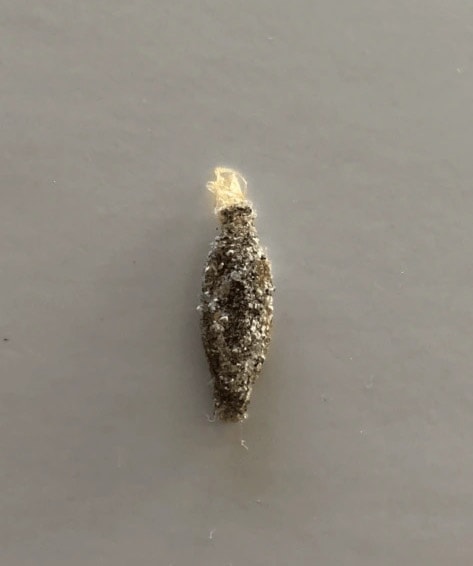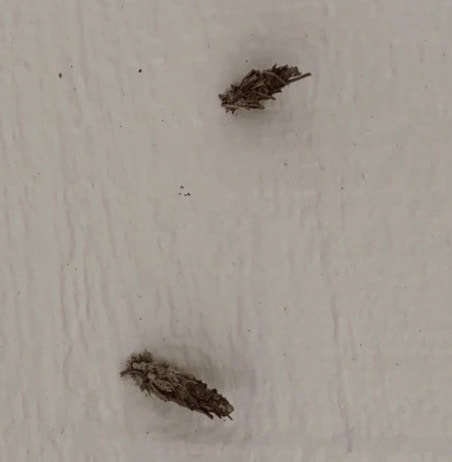Little grey bugs attached to the walls?
Small grey bugs hanging on your walls or ceiling? How to get rid of Bagworms & Casebearers
What are they?
Have you noticed small greyish to white colored bugs hanging on your walls or ceiling? Or maybe it looks like some kind of egg sac? What you are likely seeing is a cocoon-like case, with an insect hidden inside. The common name for these creatures is a Plaster Bagworm, however, it is more etymologically accurate to refer to them as Household Case Bearers (Phereoeca uterella). Dust Worms are another common name for these creatures. The long oval-shaped little case or “bag” that is most commonly found in homes and garages are the cocoon created by the larval or caterpillar stage of a moth.
Despite ultimately transforming into a moth, it is not typical to have significant numbers of moths visibly flying about the house. If this is the case, it is more likely you may have an infestation of Indian Meal Moths.

Why are they in my house?
Like people, insects have basic needs such as food and shelter, that must be met in order to survive. For Plaster Bagworms and Household Casebearer, those needs are VERY basic. Their diet consists of old spider webs, dead insects, and even human hair. Part of the reason these insects are found stuck to walls and ceilings is that they have climbed up there to be closer to the cobwebs they feed on. It doesn’t take much to satisfy a hungry Plaster Bagworm.
Household Casebearers and Plaster Bagworms are common throughout the Southeastern United States. Thriving in warm and humid climates, they are a particular nuisance in Florida where their population in and around homes can become quite high if some mitigating measures aren’t taken.
It’s very common to find Plaster Bagworms and Household Casebearers attached to the exterior stucco, vinyl or wood siding of homes as well.
Bagworms and Casebearers will eat wool, but they will not eat cotton or nylon.

What can be done about them?
Thorough Cleaning
Because both their diet and the material used to create their cocoon is basically tiny bits of organic material, thorough and consistent cleaning can remove both the food and shelter they need to survive and result in a decreased population. This, however, can be a bit difficult in areas such as garages, carports, patio, and lanai areas. Nevertheless, sweeping down cobwebs, and blowing out accumulated debris in garages and porches will help prevent a thriving Casebearer population.
Reduce Outside Lighting
Another good tip for preventing Plaster Bagworms is to reduce outside lighting. Ultimately, these little creatures are moths. Moths are notoriously attracted to porch lights. If moths are attached by a light left on in the garage, or a security light on the side of the house, you are attracting them to your home. It is ultimately these adult female moths that will lay the eggs that eventually turn into the annoying little egg sac-like creature stuck to your ceiling.
Keep Temps & Humidity Moderate
Obviously, there is little that can be done in this regard in outside areas. There is a reason, though, that they have the name HOUSEHOLD Casebearer. They are certainly capable of surviving inside homes. Another reason why you’ll find these weird little bugs in these areas is that they, like all insects, prefer warmth and humidity. Plaster Bagworm populations will be higher in homes where the inside temperature is kept above 80 degrees. If, like many Floridians, your home is only occupied part of the year, be sure to keep your A/C running even when you are away. Click here for tips on things you can do for free that will prevent pest problems.
Vacuuming
Often homeowners will sweep down the caterpillar cases along with any cobwebs nearby. While this can be somewhat helpful, it is limited in its effectiveness in two way.
1) The moth’s larvae are well protected inside their cocoon.
2) The material they consume, spiderwebs and the remains of dead insects caught in them, simply end up on the floor, still easily available for the Plaster Bagworm to eat.
By vacuuming, whether, with a household vacuum or a shop-vac, both the bagworm itself and the material it eats are effectively removed from the premises. Remember to empty the contents of the vacuum into a garbage bag and take the bag out of the house, or you may just end up with a bunch of well-fed moths living in your vacuum.

